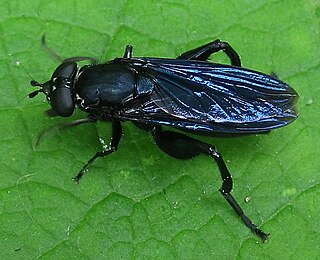
Xylota is a Holarctic genus of hoverflies similar in structure to the related genera Chalcosyrphus and Brachypalpoides. As the larvae are saprophytic they're usually found in rotting wood. The adult flies are generally associated with woodland and woodland edges and can often be seen running over the upper sides of leaves. Unlike other syrphids the adults of many species rarely visit flowers preferring instead to gather pollen from leaf surfaces. There are over 100 described species of which 12 can be found in Europe. Seven species have been recorded in Britain. Identification of species has been difficult and identifiction by photographs is risky.

Epalpus is a genus of flies in the family Tachinidae.
Austrophorocera is a genus of flies in the family Tachinidae.

Chalcosyrphus is a genus of hoverflies in the subfamily Eristalinae. Many species exhibit some degree of mimicry of various sawflies and other hymenopterans and are often brightly coloured or metallic in hue. The adults are similar in structure and behavior to the related genus Xylota but differ in larval morphology. They can be found throughout Europe, Asia, and North America and seem to prefer damper, boggy habitats. The larvae are saproxylic feeders in rotten wood in these habitats.

Scaptia is a genus of horse-fly in the tribe Scionini.

The Milesiini is a large and diverse tribe of hoverflies. They mimic wasps or hornets.

Copestylum is one of the largest genera of hoverflies in the Americas. It comprises more than 300 species, of which only four have been found outside the Americas, having probably been introduced by the importation of cacti in which the larvae live.

Milesia is a genus of very large hoverflies, which mimic social wasps. For example, the European species Milesia crabroniformis is a convincing mimic of the hornet species Vespa crabro. Milesia are predominantly Palaeotropical in distribution almost entirely Oriental.

Ocyptamus is a large and diverse genus of over 200 species of hoverfly mostly found in the Neotropical region. It is likely that many of these species will be discovered to be synonyms though many others await description.

Palpada is a genus of 85 neotropical and nearctic flower flies or hoverflies This genus is often colorful and bee-like. It is in the tribe Eristaliini containing dozens of genera Common sister genera include Eristalis (99 species), Meromacrus (43 sp.), Eristalinus (100 sp.) and Helophilus (50 sp.). The genus palpada is distinguished by:

Archytas is a genus of flies in the family Tachinidae.
Paratropidia is a subgenus of hoverflies from the family Syrphidae, in the order Diptera.
Orthoprosopa grisea is a species of hoverfly in the family Syrphidae.
Orthoprosopa xylotaeformis is a species of hoverfly in the family Syrphidae.
Orthoprosopa pacifica is a species of hoverfly in the family Syrphidae.
Sterphus is a genus of hoverflies.
Rhigioglossa is a genus of horse flies in the family Tabanidae.








